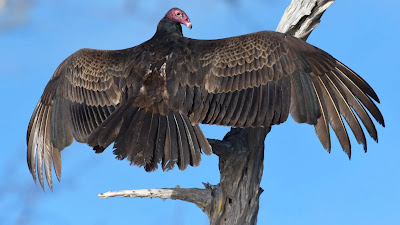“Behold the deer, the deadliest beast
in North America.”
Wha-a-a-a-t?!
Talk about “scare headlines”! But this one’s true, based on statistics
indicating that “deer are responsible for the deaths of about 440 of the
estimated 458 Americans killed in physical confrontations with wildlife in an
average year.”
That’s not deer-on-humans
confrontations, but “the unfortunate result of more than 2 million people a year
plowing into deer with their sedans and SUVs, usually on a two-lane road, often
at high speed.” That number, and others,
come from “Human-Wildlife Interactions,” as tabulated by
researchers.
The same report indicates that deer are
most dangerous in November because it’s both “rutting season” and the end of
daylight saving time; that West Virginia is most dangerous for deer-car
collisions; that deer are involved in at least 69% of animal related accident
claims; that November twilight time is the peak hour for deer-car crashes; that
dusk exceeds dawn for collision numbers because while commuters, like deer, are
also crepuscular, drivers are more likely to be out at dusk than at dawn.
https://wapo.st/3iRZFSH
In other news about deer, who comprise
a huge wildlife population in the US and Canada, people have been shown to introduce
coronavirus to white-tail deer, who then spread it to one another.
It’s theorized that people feeding deer might
be one way of passing on the virus, and deer encountering human trash or waste
could be another.
Hunters might be in jeopardy because of
their interactions with the animals. Wearing
masks and washing hands thoroughly are recommended safety precautions.
How much a hazard covid-carrying deer
may be to humans hasn’t been determined, but the number of infected animals who
spread disease among themselves makes deer a kind of reservoir for different
covid strains. And at least in the long run, that’s not good.
https://tinyurl.com/5cfw52ej
Stop
bird strikes
I’ve heard it; have you?
The “it” is the upsetting sound of a bird
flying into a window.
Worse is the sight
of an injured or dead bird under the window.
One way to try preventing that from happening
is to put silhouette stickers that look like predator birds on windows birds might
confuse with open space – near bird feeders, for instance.
Problem is, according to “solid” research, such stickers do
no good if placed inside windows, instead of outside. It’s that simple. (I’ve made that mistake, and now know how I
erred.) A related problem: finding such
stickers to begin with. With the best
intentions, I’ve applied them wrong after finding them by accident! https://tinyurl.com/3a4wc7dj
Turkey Vultures
by Maya C. Popa
Since the wind knocked
down power lines
and lightning set a
birch aflame
from within, three
turkey vultures roost
along the topmost
branches,
matted black feathers
with small red heads,
unfortunate harbingers
of death,
though really, almost
comically alive—
hunched as though
deciding
some minor point before
slipping off
on the umbrellas of
their wings to rid
the roads of evidence
of violence not theirs.
#
Last words on disaster kits – promise!
The more places I look, the more recommended items for pet
disaster kits I find. You could probably
match some of those ingredients with the person or organization advising them –
for instance, a veterinarian might say pack medical records and medicines, while
the Feds advise copies of your pet’s registration info and other relevant
documents in a waterproof container and available electronically.
And the ASPCA
recommends lining up alternative caregivers in case you and your pets can’t be
sheltered together – an especially good idea since it’s difficult or impossible
to rush your pets to ....X ... at a time of emergency, only to learn it’s not
open to pets (as is true in some community shelters). Here
are links to the ASPCA info sheets for dogs & cats https://tinyurl.com/35ene8kt and
a link
to the Fed’s suggestions: https://www.ready.gov/pets; and finally, advice of a trusted area
veterinarian appears at the end of this blog post.
With all the verbiage here lately I've hoped to motivate all of us to assemble a disaster kit
for our pet(s). By now, though, I’ve
said and written enough on this subject, and it’s up to each of us to take that
positive action. My suggestion: look at
the two links above, then the vet’s advice below, all the time noting what you
want to line up for your own own kit(s). Then get to it.
Let’s
do what our pets need us to do for them!
# # # # # # # # # # # # # # # # # # # # # # # # # # # # # # # # # # # # # #
|
|
|
A trusted veterinarian’s
advice on disaster kits
|
|
A
disaster can strike at any moment. Whether it's a fire, tornado, hurricane,
flood, or blizzard, it's critical for pet parents to be prepared and have
a plan in place. Unfortunately,
pets are sometimes left out of their families’ disaster- preparedness
plans, making it hard to know how to help them during an emergency when
quick, organized thinking is crucial.
Luckily,
we can plan ahead for pets using these tips:
1.
Listen to your veterinarian
Make sure your pets wear a collar with current information on it, get
them microchipped and have them vaccinated. These recommendations will come in handy
during a disaster and help you avoid potential pitfalls, like being
unable to get into a shelter with unvaccinated pet or losing them during
an evacuation. If possible, take
your pets’ medical records with you and attach rabies tags to their
collars. 2.
Find out which shelters allow pets Do advance research into where you can safely evacuate with your pets
during a state of emergency before a disaster occurs. Your local police department can
typically give you this information. If not, they're probably able to point
you toward someone who can. It isn’t
true that hotels must accept pets during evacuations, so please
keep that in mind while planning ahead. 3.
Prepare a pet disaster kit In a suitcase or other easily movable storage container, pack food and
water bowls, a manual can opener, two weeks’ worth of canned food and
bottled water per pet, plastic poop bags (for dogs), litter and a small
litter box (for cats), and a two-week quantity of any medications your
pets may need. You should also
pack cleaning items, sturdy leashes and harnesses, toys, and copies of
your pets’ medical records. For
small animals and cats, have a carrier ready. Use this checklist to prepare. 4.
Create handouts Create an identification handout and a boarding instruction handout. Have both ready to go at a moment's
notice. They should contain important information, such as your pets’ names,
ages, sex, markings, microchip numbers, allergies, and vaccination
status.
If
you get separated from your pets, make sure you're safe before you begin
your search. If you're in a
shelter that houses pets, tell a caretaker and provide them with the
identification handout. Once given
the OK to leave the shelter and return home, contact animal control and
call the microchip company to make sure all information about you and
your pet is current.
Stay
safe out there!
#
|
|
|
|
|
|
|
|
|




.jpg)




